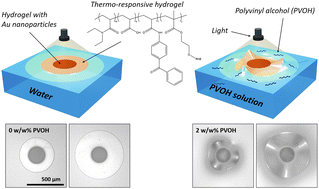In this work, we study the influence of surface tension on light-induced wrinkling of hydrogel disks containing patterned regions of photothermally-active gold nanoparticles at the air–water interface. The disks, which are initially radially stretched by the air–water surface tension, undergo wrinkling under illumination through a radially nonuniform photothermal deswelling. By tuning the surface tension of the surrounding air–water interface through variations in concentration of a poly(vinyl alcohol) surfactant, we observe a critical threshold for wrinkling, followed by a monotonic decrease in wrinkle number with decreasing surface tension. Finite element simulations performed to better understand this behavior reveal qualitatively similar trends as the experiments. The insights provided into elastocapillarity-mediated wrinkling may guide future efforts to control interfacial behaviour of reconfigurable and shape-morphing films.
